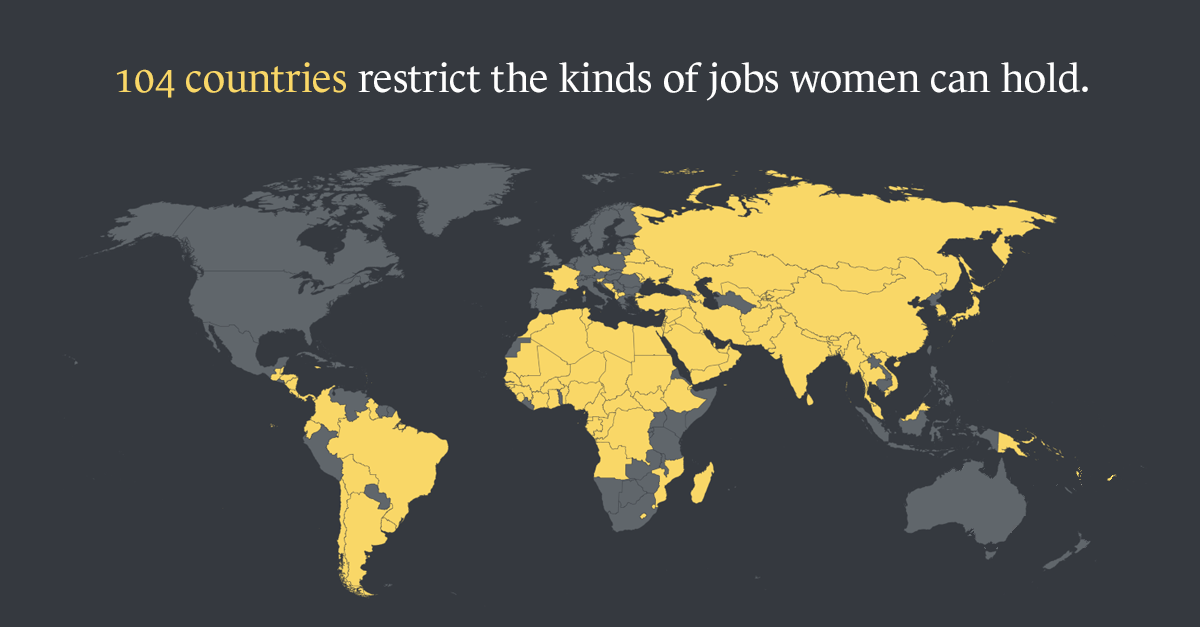
Growing Economies
Through Gender Parity
Sia Kambou/AFP/Getty Images
Closing the gender gap in the workforce could add a staggering $28 trillion to the global GDP.
GDP Growth by 2025 with gender parity in the workforce
all regions
Both advanced and developing countries stand to gain if women participate in the labor force at the same rate as men, work the same number of hours as men, and are employed at the same levels as men across sectors. Even without full parity, countries can grow the global gross domestic product (GDP) by $12 trillion by matching the rate of progress toward parity of their region's fastest-improving country. See the methodology for more on the factors that influence how much a country gains.

Fred Dufour/AFP/Getty Images
Despite the benefits of women's economic participation, significant legal, structural, and cultural obstacles persist.
The McKinsey Global Institute identified four primary issues that, if addressed, will help achieve gender equality at work more quickly: education level, financial and digital inclusion, legal protection, and unpaid care work.
-
59
countries have no law prohibiting sexual harassment or abuse in the workplace
Source:
World Bank -
300%
more time is spent on unpaid care work by women than men
Source:
OECD -
2⁄3
of the 750 million illiterate adults worldwide are women
Source:
UNESCO -
190M
fewer women than men have a bank account
Source:
World Bank

Mohammed Salem/Reuters
What does this mean for your country?
Select a country below to see the potential economic gains from gender equality — and the barriers standing in the way.
Economic Gains
Global GDP could increase 26 percent by closing the gaps between women and men in the workforce, which would benefit both advanced and developing countries. Even without full parity, countries can increase their economic growth by matching the rate of progress of their region's fastest-improving country.
GDP gains by 2025
If women's participation in
is fully equal to men's
matches best in region*
If women's participation in
is fully equal to men's
Gender Parity
To be equal participants in work, women need to be equal partners in society — in schools, health services, financial systems, legal institutions, and families. Cultural beliefs, from justifying domestic violence to considering it unacceptable for women to work outside the home, need to shift for women to improve their status.
How far is from gender parity?
Scores are measured on a scale of 0 to 100, where 100 represents full parity. The country that is closest to parity in the region is on the right.
Gender Equality in Work
Compares women's and men's ability to find employment and be compensated fairly for it, share unpaid care work equitably, have the skills and opportunity to perform high-productivity jobs, and occupy leadership positions.
Essential Services
Compares women's and men's access to health care, education, and financial and digital services, which are vital to economic participation.
Legal Protection and Political Voice
Compares women's and men's legal rights to self-determination, including the right to work, access institutions, inherit assets, and have the opportunity to participate in political life.
Physical Security and Autonomy
Assesses women's safety from bodily harm, including from gender-based violence and child marriage.
Overall Gender Parity
Barriers to Gender Parity
Of the indicators used to measure gender parity, the McKinsey Global Institute identified four specific issues — education level, financial and digital inclusion, legal protection, and unpaid care work—that, if addressed, will do the most to achieve gender equality at work and generate significant progress toward realizing economic gains.

Vincent Kessler/Reuters
Policy Responses
-
1
Incentivize legal and policy reform -
2
Increase women's access to capital and financial services -
3
Create an economic-inclusion challenge fund -
4
Promote technology and innovation -
5
Support research and data collection -
6
Enact U.S. domestic polices to lead by example
Case Studies
Explore policies employed by four countries to increase women's labor force participation.

Women's Workplace Equality Index
Despite the financial stakes, most countries still have laws that make it harder for women to work. Explore the first-ever global index ranking 189 countries on legal gender equality in the workplace.
See the interactive report


